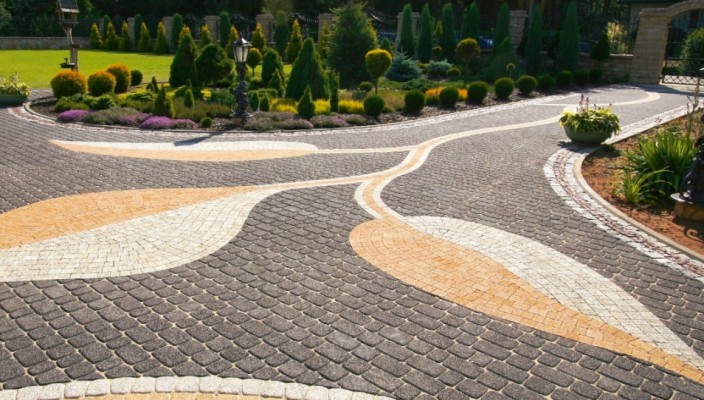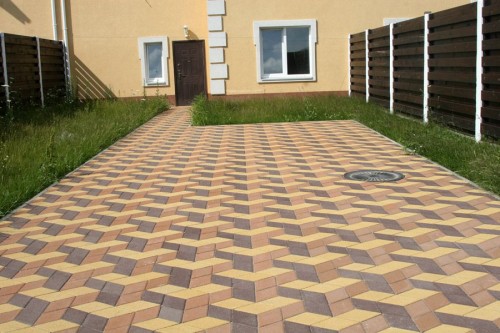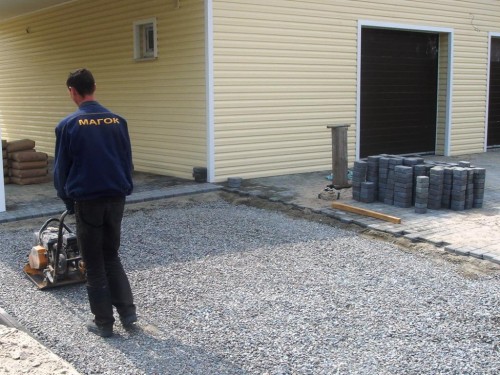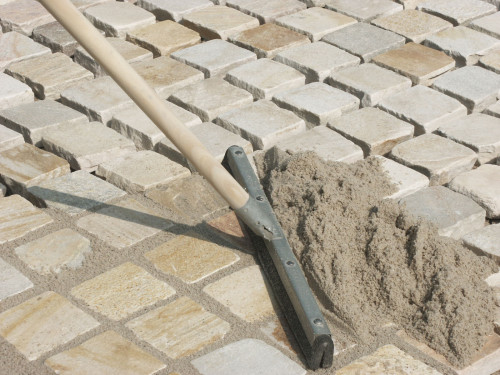Paving tile is a fairly high-strength product. To increase its operational period, it is necessary to put it high quality. Our article we will talk about the features of laying paving slabs on crushed stone.
Content
How to get the coating paving slabs
Immediately should determine where the paving slabs will be used. This is explained by the fact that the material has different thickness. Naturally, for the car parking, the tile should be thicker than material intended for garden tracks.
In addition to size, paving slabs can have different patterns and shapes. But these indicators are secondary when buying a material.
Attention should be paid to:
- Tile surface. In the presence of chips, its porosity is checked. If the material is covered with numerous small "pits" or large "chops", this indicates low quality paving.
- Drying coating. To do this, take two tiles and gently knock on each other. The presence of a ringing sound speaks of a well dried material. The appearance of a deaf sound is associated with a bad drying. Such a tile is fragile and serves the minimum amount of time.
- Mirror surface of the material. It is also determined by rubbing two tiles. If the coating becomes rough and a little darker, then it is better to refuse it. These phenomena indicate the presence of too much water (or additives) in the material.
- Color shade. A large number of dye speak bright and rich colors. Such a material will quickly crack and crumble.
- Quality certificates for products.
In any case, to comply with the technology of laying paving slabs, it is necessary to purchase material with a reserve of 10-15%. This is because:
- in the process of work, you will have to deal with tiles;
- a batch of defective products may be discovered.
High-quality laying of blocks is impossible without careful preparation of the base. Therefore, it will be part of what the crushed stone is needed for laying paving slabs.
Criteria for choosing rubble
When purchasing rubble, the following characteristics should be taken into account:
- fraction size;
- beschy of material;
- a variety of rubble;
- his frost resistance.
The most common fraction of rubble for paving slabs has a diameter of 0.5-2 cm. Due to the different diameter, a dense and homogeneous coating is obtained during the rubble seal. If a thin tile is used, then you can use the scope of up to 1.5 mm.
The bodybaste shows the proportion of rubble, which has a needle and flat shape. It is forbidden to use a material with a leaching exceeding 15%. With too much the number of plane rubble, the adhesion between the stones will decrease and the consumption of the cement mixture will increase. Purchased crushed stone should relate to 1 or 2 group of brees.
Among the many types of material is the best solution - the use of granite calibrated rubble, which does not contain clay or ya impurities. Thanks to the rough surface, granite has high adhesive properties (which cannot be said about the river or sea gravel).
Buying rubble, which has a high frost resistance, will increase the operating period of the paving coating. It can serve within 35-45 years.
Many are wondering what crushed stone is needed for sidewalk tiles when it is laying in different seats of country territory? To create garden tracks, a layer of rubble is enough to 30 cm (the specific thickness is determined, based on the characteristics of the soil), including:
- fraction with a diameter of 0.5-2 cm - layer to 25 cm;
- 2-5 mm - up to 5 cm.
If the coating will be driving vehicles (the maximum load does not exceed 8 tons), then the minimum height of the paving slabs should be at least 8 cm, and the layer of rubble - 0.5 m:
- fraction 2-4 cm - 0.4 m;
- 0.5-2 cm - 0.1 m;
- 2-5 mm - 3-4 cm.
Mounting work
Laying with their own hands paving slabs on crushed stone begins with the preparation of the base:
- a fertile soil layer is removed;
- plant roots and trees are selected;
- stacked pipes for drainage;
- the base is trambed.
After the preparatory stage:
- crushed stone with a layer of 20 cm;
- stones are aligned and trambed;
- bordours are installed at the edges of the sidewalk (they can "plant" on a concrete solution);
- laying tiles on crushed stone;
- for alignment of the coating, a rubber cusion is used (if the tile does not lie down exactly, it will have to raise it and additionally align the base);
- the created sidewalk is abundantly watering with water;
- after drying the coating, the interconnect seams are filled with fine sand (it is done with a brush that has a rigid bristle);
- the pavement is repeatedly watering with water (the remains of sand and dirt are washed).
So that the tile on the crushed stone is properly and smoothly, it is better to use the fishing line. It is tensioned at the height of laying the paving coating both in the longitudinal and in the transverse direction.
Masonry work is carried out in such a way that the tiles in height coincide with the top of the border. This will contribute to the proper waters of moisture (rainwater will not accumulate on the surface of the coating).
In the process of work, you should create a bias with cuvettes where water will be drained. A bias is made from the central part of the track (platform). Side cuvettes are placed at a distance of 25-30 cm from the curb.
To cut the paving slabs, the Bulgarian is used, equipped with a stone disk. Laying of the cropped coating is performed at the final stage.
And a few words about how to properly put the paving slabs on the sand.
Features of laying paving slabs on sand
At the preparatory stage:
- the form and size of the site with the application of the paper drawing on paper is determined;
- placement works are carried out (the fishing line is stretched, pegs are rush);
- the base is prepared (the old coating is removed, the soil layer is removed with a thickness of up to 0.2 m, purified from stones and roots of plants);
- with a close arrangement of groundwater, a drainage system is created (laying of perforated pipes is produced at a depth of 0.7-0.8 m);
- the surface is aligned and tamped.
Now directly on how to put the pavement tile on the sand:
- the base is covered with rubble and sand (15-20 cm);
- sand is aligned and poured with water;
- a concrete solution is made to which borders are mounted;
- the tile laying is carried out with a pitch of 4-7 mm;
- with the help of rubber inquiry and the construction level, the coating is placed in a strictly horizontal position;
- interloccine seams are filled with sainted sand;
- excess sand and the dirt that appeared is removed by a jet of water.
In the preparation of the foundation, you can use geotextile, which is laid between rubble and sand. The main purpose of the material is to prevent the growth of plants that destroy the coating. And sand over time will not "leak" through the crushed stone.
Video about laying paving slabs:
























